Ready...Set...Launch!!
By Barbara Wolcott
Photographs by Jim Gensheimer
At an annual district derby, Cub Scouts use tape, tubing, paper, and soft drink bottles to build model rockets, then send them skyward propelled by compressed air and water.
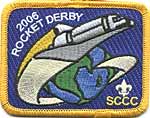
At half past noon on a sunny Saturday in April, excited Cub Scouts and their parents began arriving at San Jose's Rainbow Park for the fifth annual Water Rocket Derby.
Anticipation was everywhere, because the next four hours promised both fun and challenges, as young rocketeers built and then launched water- and compressed air-powered "bottle rockets."
The event, hosted by the Pioneer District of California's Santa Clara County Council, is open to all council Cub Scouts. It provides a half-day activity for up to 150 boys and their families, said Wesley Wong, a longtime Cub Scout leader who helped create the first derby and for six years has taught a rocketry class at the council's annual Cub Scout leader pow wow.
The goals and format are similar to other Cub Scout miniature racing events—the pinewood derby, raingutter regatta, and space derby. (See "Cub Scout Derby Choices".)
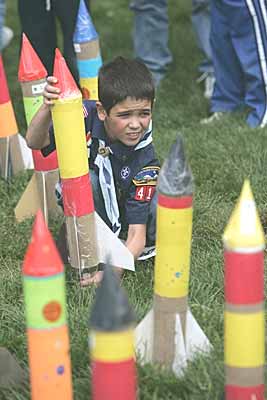 Wolf Cub Scout Patrick Fox, San Jose Pack 411, adds his rocket to the other entries in the staging area. |
Having a blast
Upon arrival at the derby site, Cub Scouts put together, with a parent's help, a simple rocket, using tape, shipping tubes, paper, cardboard, and an empty soft drink bottle.
Then, propelled by compressed air and water, the rockets are launched, one at a time, and judged for the amount of time aloft.
Emily Kriech was accompanying her Cub Scout sons. "We love this event," she said. "It's a lot of fun and we don't have to bring anything because all the materials for building a model rocket are here."
Her sons are veteran rocket derby participants, she added. "As we were leaving the house this time, my little one ran into his room to get his rocket from last year. He didn't realize they get to make a new one each time."
Cub Scout Andrew Goodman of Pack 444 was attending his third Water Rocket Derby and planned to benefit from his past experiences.
"I didn't win last year, but we had a lot of fun and I did pretty well," Andrew observed. "And this year we brought stuff from home, so we don't have to wait to use things, like scissors and tape."
"Last year we had a blast, no pun intended," added Andrew's father, Mike Goodman, who admitted that sometimes it isn't easy for a parent to leave most of the rocket construction up to the Cub Scout.
However, some parent participation is an important part of the experience, said Grace Lien, who came with her son, Paul, and other Pack 454 families.
In addition to being exciting, the derby "is a parent-and-child development activity," she pointed out, "because the kids need our help during some steps in constructing a rocket, like taping it together."
Ready to launch
For a $5 fee, all Cub Scout participants were registered ahead of time and entered in one of four categories: Tiger Cub, Wolf, Bear, and Webelos Scout.
After signing in, each boy received a numbered sticker for his shirt and another for his rocket, along with a card for the judges to enter flight times. The sticker entitled the Cub Scout to a plastic bag containing materials and instructions for making a rocket. (See "Build and Launch a Bottle Rocket".)
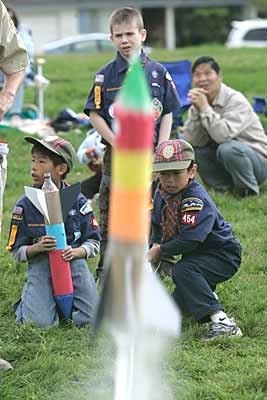 Webelos Scout Paul Lien, Pack 454, pulls the rope to send his rocket off the launchpad. |
By 2 P. M. all rockets were finished and placed in the staging area. Before flight competition began, however, an opening ceremony featuring a recording of "The Star Spangled Banner" was staged.
At the moment when the words "...the rockets' red glare" occurred, derby staff wowed the audience by blasting skyward four model rockets from the launch area.
Wesley Wong then asked for, and quickly got, 12 adult volunteers to help run the launches.
Waiting until the derby starts before asking for adult volunteers to serve as staff has worked well, Wong said. Because of the enthusiastic turnout, he has never failed to get more than enough parents willing to help with fueling stations, timing rockets, and ensuring the safety of entrants at the launch pads.
In fact, only two other adults are on the permanent organizing committee with Wong. Bob Wedig, assistant Scoutmaster of Troop 476, handles derby promotion and serves as emcee and announcer on derby day. Vince Ventura, Scoutmaster of Troop 74, serves as "launch master," supervising the launch area and making sure launch pads, hoses, and air compressor are operational.
The launch area was cordoned off with yellow tape while a line of safety cones limited access to the landing area. Rocket launching started with Tiger Cubs, followed by the Wolf, Bear, and Webelos Scout groups.
When directed, Cub Scouts lined up and took their rockets from the staging area to the launch site, stopping en route at the "fueling station."
Volunteers "fueled" each rocket by filling it almost one-third full with water, often joking with the boys that the liquid was highly volatile, "consisting of hydrogen and oxygen."
Having taken that admonition seriously, first-year Cub Scouts could be seen carefully holding their rockets bottom end-up as they waited in the launch area, so none of the "dangerous fuel" would spill out through the bottle opening.
By the clock
The program allowed every Cub Scout two opportunities to fly his rocket. Four competitors at a time were called to the launch pad, each giving his time card to one of four judges. Rockets were then launched individually, with all four judges clocking its flight time with stopwatches.
Judges clicked their watches at the moment a Cub Scout pulled the launch rope, which released his pressurized rocket skyward.
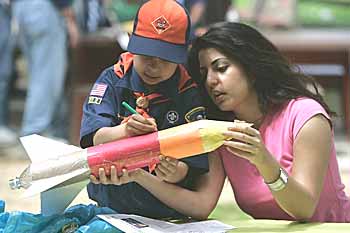 Sassan Hashemi, Pack 411, puts the finishing touches on his rocket with a helping hand from his aunt, Tara Hashemi. |
Timing continued until the rocket touched back on the ground (or landed in a tree). The two flight times on a Cub Scout's card were added together for a total score.
A typical best flight time was 12 to 13 seconds. However, an impressive altitude reached after launch would not always mean that a rocket would end up with a top time, Wesley Wong warned.
Due to design differences, some rockets do not ascend as high as others but float down more slowly, resulting in a greater total flight time.
"Random variables effect flight, such as how the fins and nose cone are attached," Wong explained.
Despite the focus on flight times, the organizers tried not to overemphasize "the competitive side of the event," he added. "We realize that the Cub Scouts and parents are here mainly to have fun."
As a result, every entrant at each year's event goes home not only with a handmade bottle rocket but also with a newly-designed patch and ribbon.
Winners, however, are duly recognized, with the top three rockets in each group receiving gold, silver, and bronze medals.
Barbara Wolcott lives in San Luis Obispo, Calif.
Build and Launch a Bottle RocketThe bottle rocket model built by Cub Scouts at the Water Rocket Derby features a two-piece body made from a 3-inch-wide cardboard mailing tube. A tube end cap is inserted in the top of the 6-inch bottom section which is then connected with tape to the 12-inch top section. A nose cone, cut from heavy-duty poster paper, is taped to the top, and three fins, shaped from scrap matte board, are inserted in slots in the lower section. (Excess pieces of mat board were purchased for $1 for a large bag from an art supply store's framing department.)
All materials for building one rocket are put into individual plastic bags (saved by neighbors from newspaper deliveries) and distributed to Cub Scouts at the derby. Two sheets of colored paper and one of glitter stickers are added to each bag so even the youngest Cub Scout, with the help of a parent, can make a rocket uniquely his own. Each work table at the derby site had several pairs of scissors and rolls of 2-inch-wide clear packaging tape. Volunteer Boy Scouts went from table to table helping with the construction. Prior to launching, a strip of plastic "fun foam" is wrapped around an empty 20-oz. plastic soft drink bottle to insure a tight seal. The bottle is then inserted, top down, into the rocket's bottom section, with the open bottle mouth sticking out. About one-third of the bottle is filled with water. The Cub Scout, holding the rocket upside down, hands the rocket to an adult, who turns it over and quickly puts it on the stem of the launcher. (A garden hose gasket on the launcher stem provides a close fit.) The rocket locks into place with a snap/spring connection. The bottom of the launcher stem is fitted with an automotive tire valve stem, through which air is pumped into the rocket bottle. When pressure is up and stabilized at from 60 to 80 pounds per square inch, depending on wind conditions, the signal is given and the Cub Scout pulls a release rope to launch the rocket. The pressurized air and water blasting out of the bottle mouth cause the rocket to be propelled upward. Each rocket must descend completely before the next one goes up. "We tell the boys to pull easy but because they can get excited and jerk the rope, we have to stake down the launch pad pipe structure," derby organizer Wesley Wong said. Derby activities can satisfy the "make a rocket model" requirements for Wolf and Bear elective and achievement. For the Webelos Scientist activity badge, the derby teaches the effects of air pressure, and shows the effects of water and air pressure. Also fulfilled is the requirement to build and launch a model rocket. The bottle rocket instructions Wesley Wong uses in his pow wow class can be downloaded from http://wwong.homestead.com/rockets.html. Instructions for making different types of launchers or for buying a readymade version are available on the Web. —B.W. |
What Can Go Wrong, Just Might...Unanticipated problems can wreck an event like the Water Rocket Derby, so Wesley Wong keeps a small supply of backup materials on hand for possible repairs. He also makes sure to have a gas-powered backup generator for the electric air pumps that power each launcher. The park area where the derby is held has a single electrical outlet and an incident at an earlier derby demonstrated the need for such a device. The Cub Scouts were sharing the area with a family that was holding a birthday party and had brought an inflatable jumping house for the occasion. However, when the unit's air pump was plugged in, the power went out. The fuse box was locked and park personnel did not work on weekends, so Wong chased around town to find a backup generator to finish the event. Despite the delay, the program was able to resume less than 40 minutes behind schedule. At the 2006 derby, the batteries in one of the timer's stopwatches went dead. Unruffled, Wong asked if any parent had a wristwatch with stopwatch capability. Someone volunteered a watch and the program proceeded as planned. —B.W. |
Cub Scout Derby ChoicesCub Scout packs have traditionally held three types of official derby events, designed to provide fun and excitement while fostering parent-child involvement and a sense of accomplishment. The best-known is the pinewood derby, which dates back to 1954. Cub Scouts fashion model cars from blocks of wood, attach wheels and weights, and race them, powered by gravity, down an inclined track.
For the space derby, a Cub Scout builds a balsa wood rocket which uses a rubber band-powered propeller to race against the clock while attached to a horizontal string track. Kits for cars, boats, and rockets, plus accessories for building them and staging derby events, are available from the Supply Group's BSA Official Retail Catalog, Scout shops, Scouting retailers, or the Web site, www.scoutstuff.org. Also available is the Cub Scout Grand Prix Pinewood Derby Guidebook (No. 33721A), which also includes tips on holding a raingutter regatta and a space derby. In addition to kits for traditional derbies, the Supply Group has added a Water Rocket Kit (No. 17951) which includes a simple-to-build water rocket (launched with air pressure from a bicycle pump) and learning activities that can be accomplished by using the kit. Also new is Blast Off! Rocket Science Book Kit (No. 33971). It features a simple foam and plastic rocket, powered by baking soda and vinegar, to use in learning about rockets and their history. The Supply Group also carries Estes Rocket Kits. However, these require model-building skill beyond the level of most Cub Scouts and use ignitable engines, which means safety is a high priority and adult supervision is strongly recommended. |
November - December 2006 Table of Contents
Copyright © 2006 by the Boy Scouts of America. All rights thereunder reserved; anything appearing in Scouting magazine or on its Web site may not be reprinted either wholly or in part without written permission. Because of freedom given authors, opinions may not reflect official concurrence.
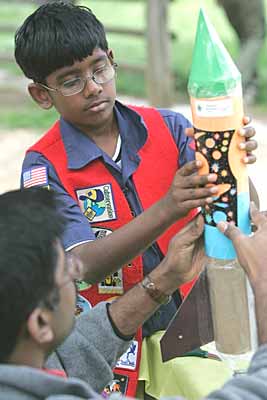
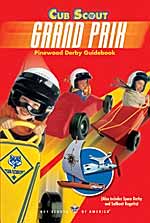 The raingutter regatta features miniature sailboats, powered only by wind (a Cub Scout's ability to blow) racing side-by-side through a trough of water.
The raingutter regatta features miniature sailboats, powered only by wind (a Cub Scout's ability to blow) racing side-by-side through a trough of water.